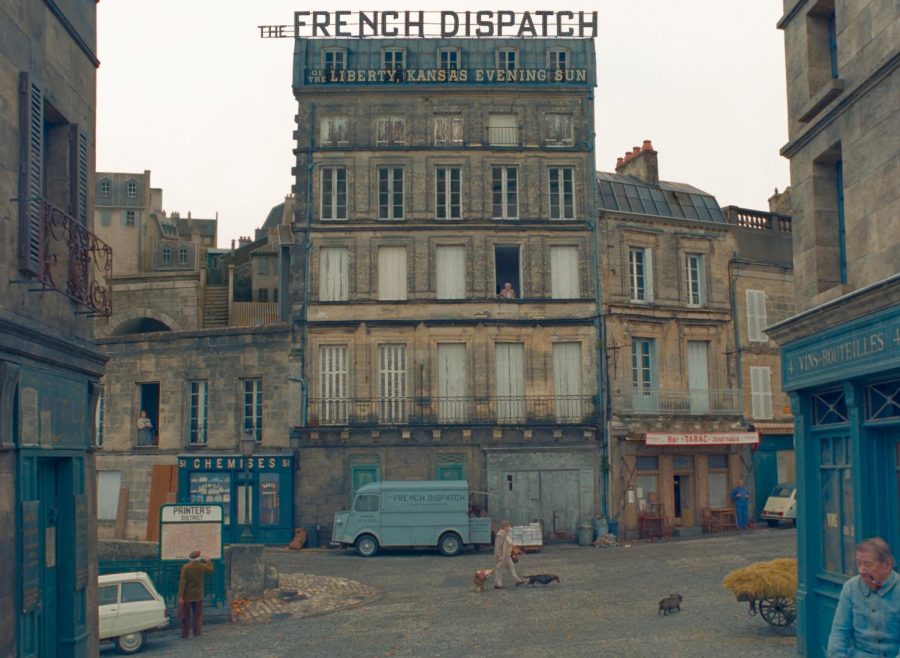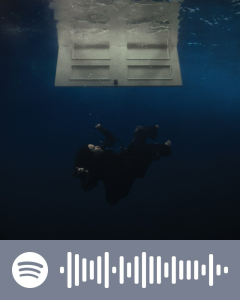“The French Dispatch”: a cinematic love letter to journalism
November 9, 2021
This previously ran in our October 2021 print issue.
Wes Anderson has been making movies for almost 30 years, and he’s been doing it almost the same way every time. Yet, there’s something different about The French Dispatch.
After countless delays, having originally been scheduled to release in July 2020, the film is finally releasing in October 2021, over a year later. Rightfully so, it has been one of the most anticipated movies since then. The film features one of the most stunning casts in recent memory: Bill Murray, Tilda Swinton, Timothée Chalamet, Benicio del Toro, Frances McDormand, Jeffrey Wright, and many more. Yet, with any Anderson film, there are always the nay-sayers. Those who shout to their uninterested audiences about how “repetitive” his films are.
And yes, it has all of his hallmark, idiosyncratic visual characteristics (and really there is nothing wrong with that). But at the same time, something feels different with this film. With the anthology format, featuring multiple virtually disconnected segments, The French Dispatch breathes life into the Wes Anderson formula for its dissenters and provides an interesting change of pace for devoted fans.
The core of the film is the eponymous French outpost for an American newspaper which produces a magazine titled “The French Dispatch.” Yes, it’s confusing, but thankfully the film itself is organized in a very purposeful way. Each segment of the film is a different article in an issue of the magazine. Each segment presents itself as a self-contained vignette of Anderson’s singular style.
The film begins with a brief introduction explaining the various writers, editors, and illustrators of the magazine. After this, the audience is treated to their first vignette, Owen Wilson’s character’s travelogue of the French city Ennui. While this segment takes up a very brief portion of the film, it’s an endearing chapter that sets the tone for the rest of the film fairly well. And obviously, Owen Wilson is wonderful as the slapstick-comedy cyclist, Herbsaint Sazerac, reminiscent of the works of Jacques Tati.
After this brief detour with the bicycling journalist, the film continues with the first of three larger segments: a story centered around the imprisoned artist Moses Rosenthaler, played by Benicio del Toro. In this segment, Rosenthaler’s muse is actually his prison guard, Simone, played by Léa Seydoux. While this segment does suffer from a lack of any characters with true emotional depth, it presents some of the funniest moments in the film and a great appearance from Tilda Swinton as an art historian. It also features some of the most interesting work with space and time, as when the audience is watching the segment they’re really watching a story within a story within a story. While it certainly isn’t the best chapter of the film, it is still a wonderfully entertaining outing for del Toro, Swinton, Brody, and Seydoux.
After this, the film moves on to a strange midpoint: a segment which calls to mind countless images from Les Misérables, as it follows the story of a group of young revolutionaries in France. While it does feature nice appearances from both Frances McDormand and Timothée Chalamet, it’s unfortunately the weakest segment of the film. The writing simply isn’t all there, and it lacks any real sense of stakes. Despite this, it does still boast probably the most humorous moments in the film and one of the best music choices with the needle drop of “Aline” by Christophe.
The film concludes with unequivocally the best section: a food review turned gripping news story starring Jeffrey Wright as Roebuck Wright. In this segment, Wright is assigned to review the food of the police department’s chef, Lt. Nescaffier played by the wonderful Steve Park. However, it is revealed that the police chief’s son has been kidnapped, and Wright is forced to cover this for most of his article as opposed to the actual food. With the clearly strongest emotional core of the entire film, Anderson framed this chapter as Wright retelling his experience writing the article on a television show years later. This fact alone places this segment in a much more personal, nostalgic light than the others, even going so far as to show when Bill Murray as the editor in chief first hires Wright for the staff of “The French Dispatch.”
Yet, the most emotionally affecting scene of this section is an intimate moment between Park’s Nescaffier and Wright’s Wright (yes it sounds funny, but his real life last name is in fact his character’s last name). In this brief interaction, Wright shares some of the most emotionally resonant, thematically poignant lines of the entire film, essentially acting as a conduit for the film’s themes at large.
With a spectacularly stunning conclusion and a strong first two acts, The French Dispatch is easily one of the best films so far this year and one of Wes Anderson’s best.
The film started a limited release in select cities on Oct. 21 with a wide release on Oct. 28.











